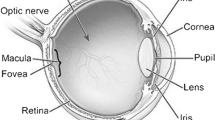Abstract
The results of the first clinical trial are presented of the newly designed tumor-seeking radiopharmaceuticall-3-123I-iodo-α-methyltyrosine (IMT) for noncontact detection of malignant eye melanoma by means of a nuclear medicine technique. Eye scintigraphy (ES) was performed on ten outpatients clinically suspected of harboring an intraocular melanoma. ES was carried out with a twin pinhole eye collimator attached to a high resolution gamma camera; 7–10 mCi of IMT was given intravenously to each patient 100–150 min prior to the nuclear medicine investigation. Gamma camera eye scintigraphy and the use of IMT offer a useful noninvasive alternative to the radiophosphorus uptake test. Of the ten patients, five were found not to have a melanoma either clinically or by scintigraphy, three had a melanoma by scintigraphy that was confirmed histologically, and two yielded inconclusive results.
Zusammenfassung
Die erste klinische Anwendung des neuen Radiopharmakonsl-3-123-I-Iodo-α-Methyltyrosin (IMT) zum nuklearmedizinischen Nachweis des malignen Augen-Melanoms wird dargestellt. Es wurden 10 Poliklinik-Patienten mit Verdacht auf ein Melanom des Auges untersucht. Die Augen-Szintigraphie (ES) wird mit einem Zwillings-Lochblenden-Kollimator an einer Gamma-Kamera durchgeführt. 7–10 mCi IMT werden 100–150 min vor der Untersuchung i.v. appliziert. Die Augen-Szintigraphie mit Hilfe einer Gamma-Kamera unter Verwendung des Radiopharmakons IMT eröffnet eine brauchbare, nicht-invasive Untersuchungsmethode als Alternative zum Radiophosphor-Test. Von 10 untersuchten Patienten ließen sich 5 Fälle zusammenfassen, die weder klinisch, noch szintigraphisch ein Melanom hatten. Bei 3 Patienten ließ sich ein Augenmelanom eindeutig nachweisen und histopathologisch bestätigen. Bei 2 Patienten ergaben sich nichtschlüssige Resultate.
Similar content being viewed by others
References
Altenbrunn HJ (1971) Present prospects for positive tumor localization by scintiscan. In: Horst W (ed) Frontiers of nuclear medicine. Springer, New York, pp 230–249
Blanquet P, Verin Ph, Safi N (1974) La scintigraphie oculaire. Nouv Presse Med 34: 2154–2158
Bockslaff H, Jahns E, Hundeshagen H (1978) Kamera-Szintigraphie mit einem Doppel-Lochblenden-Kollimator zur nicht invasiven Diagnose intraokularer Tumore. In: Höfer R (ed) Radioaktive Isotope in Klinik und Forschung [Suppl 13]. Egermann Publishers, Vienna, pp 341–348
Bockslaff H, Dausch D, Bornemann H, Stöppler L, Hundeshagen H (1979) Noncontact detection of intraocular lesions by means of a gamma scintillation camera. Concept and clinical examples. Graefe's Arch Clin Ophthalmol 211: 187–203
Bockslaff H, Kloster G, Safi N, Blanquet P (1980) L-3-123I-iodo-α-methyltyrosine or 6-123Iodochloroquine as imaging agents for the detection of malignant melanoma: A comparative study on tumor bearing Syrian golden hamsters. In: Höfer R, Bergmann H (eds) Radioaktive Isotope in Klinik und Forschung. Egermann Publishers, Vienna, pp 171–178
Bockslaff H, Spitznas M, Hahn I, Kloster G (1981) Noncontact detection of experimental ocular melanoma with L-3-123I-iodo-α-methyltyrosine. Graefe's Arch Clin Ophthalmol 217: 255–266
Boer Iwema R, Pauwels EKJ, Oosterhuis JA (1980) Results of isotope scanning with radioactive gallium and technetium and with P-32 in patients with intraocular melanomas. Ophthalmologica 81: 277
Bornemann H, Dausch D, Gröne WD, Creutzig H, Knoop B, Michelson W, Bockslaff H, Hundeshagen H (1980) Digitale Sequenzszintigraphie bei Augenerkrankungen. In: Schmidt HAE, Woldring M (eds) Nuklearmedizin [Suppl 17]. Schattauer, Stuttgart pp 873–876
Bruno GA (1976) Radiopharmaceuticals in nuclear ophthalmology. In: Croll MN, Brady LW, Carmichael P, Wallner RJ (eds) Nuclear ophthalmology. J Wiley, New York, pp 25–34
Grove RB (1976) High resolution pinhole scintiphotography of the orbits and orbital adnexae. In: Croll MN, Brady LW, Carmichael P, Wallner RJ (eds) Nuclear ophthalmology. J Wiley, New York, pp 267–280
Harris CC (1976) Nuclear medical instrumentation. In: Croll MN, Brady LW, Carmichael P, Wallner RJ (eds) Nuclear ophthalmology. J. Wiley, New York, pp 7–34
Heindel NC (1976) The chemistry of radiopharmaceuticals for noncontact detection of ocular tumors. In: Croll MN, Brady LW, Carmichael P, Wallner RJ (eds) Nuclear ophthalmology. J. Wiley, New York, pp 103–110
Ivanez-Allochery M (1979) Interêt de la scintigraphie au citrate de Gallium 67 en ophthalmologie. Lille, Thèse de Doctorat en Médecine
Kloss G, Leven M (1979) Accumulation of radioiodinated tyrosine derivatives in the adrenal medulla and in melanomas. Eur J Nucl Med 4: 179–186
Kloster G, Bockslaff H (1982) L-3-123I-α-methyltyrosine for melanoma detection: A comparative evaluation. Int J Nucl Med Biol (in press)
Mishkin FS, Maynard P (1974) Lacrimal gland accumulation of67Ga. J Nucl Med 15: 630–631
Moyer RA (1974) A low energy multihole converging collimator compared with a pinhole collimator. J Nucl Med 15: 59
O'Rourke J (1976) Radionuclide uptake for detection of malignancy in small choroidal melanoma. In: O'Rourke J (ed) Nuclear ophthalmology. Saunders, Philadephia, pp 92–107
Packer, S (1977) Ocular tumor localizing radionuclides. In: Spencer RP (ed) CRC Handbook Series in Clinical Laboratory Science, Section A: Nuclear Medicine, Vol. 1 CRC Press, Cleveland, pp 72–78
Packer S, Redvanly C, Lambrecht RM, Wolf AP, Atkins HL (1975) Quinoline analog labelled with iodine-123 in melanoma detection. Arch Opthalmol 93: 504–508
Packer S, Lambrecht RM, Christman DR, Ansari AN, Wolf AP, Atkins HL (1977) Metal isotopes used as radioactive indicators of ocular melanoma. Am J Ophthalmol 83: 80–94
Packer S, Lambrecht RM, Wainstock M, Rogers WL, Margouleff D, Goldberg H (1982) Techniques for nuclear detection of intraocular melanoma. In: Schmidt HAE, Woldring M (eds) Nuklearmedizin [Suppl 18]. Schattauer, Stuttgart, pp 845–847
Rollo FD, Harris CC (1977) Factors affecting image formation. Pinhole collimators. In: Rollo FD (ed) Nuclear medicine physics, instrumentation and agents. Mosby, Saint Louis, pp 387–435
Stöcklin G (1977) Bromine-77 and iodine-123 radiopharmaceuticals. Int J Appl Radiat Isot 28: 131–147
Tisljar U, Kloster G, Ritzl F, Stöcklin G (1979) Accumulation of radioiodinated L-α-methyltyrosine in pancreas of mice: Concise communication. J Nucl Med 20: 973–976
Weinreb R, Yavitz E, O'Connor G, Barth RA (1981) Lacrimal gland uptake of gallium citrate Ga 67. Am J Ophthalmol 92: 16–20
Weinreich R, Schult O, Stöcklin G (1974) Production of123I via the127I(d,6n)123Xe(β+,EC)123I process. Int J Appl Radiat Isot 25: 535–543
Author information
Authors and Affiliations
Rights and permissions
About this article
Cite this article
Bockslaff, H., Kloster, G., Dausch, D. et al. Noncontact detection of ocular melanoma withl-3-123I-Iodo-α-methyltyrosine: First clinical results. Graefe's Arch Clin Exp Ophthalmol 219, 149–154 (1982). https://doi.org/10.1007/BF02152302
Received:
Issue Date:
DOI: https://doi.org/10.1007/BF02152302




